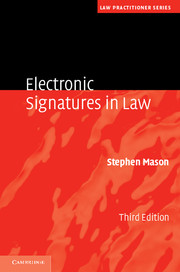Book contents
- Frontmatter
- Contents
- Preface
- Acknowledgements
- Table of cases
- 1 The signature
- 2 International initiatives
- 3 European Union Directive on electronic signatures
- 4 England and Wales, Northern Ireland and Scotland
- 5 International comparison of electronic signature laws
- 6 The form of an electronic signature
- 7 Digital signatures
- 8 Liability
- 9 Evidence
- 10 Data protection
- Index
- References
1 - The signature
- Frontmatter
- Contents
- Preface
- Acknowledgements
- Table of cases
- 1 The signature
- 2 International initiatives
- 3 European Union Directive on electronic signatures
- 4 England and Wales, Northern Ireland and Scotland
- 5 International comparison of electronic signature laws
- 6 The form of an electronic signature
- 7 Digital signatures
- 8 Liability
- 9 Evidence
- 10 Data protection
- Index
- References
Summary
The purpose of this chapter is to put the concept of the signature into a broad legal context: to set out the purposes that can be attributed to a signature and to explain the functions a signature is capable of performing. In order to appreciate what constitutes an electronic signature, it is helpful to understand the function a signature performs and how judges have responded to changes in technology over the generations. It is for this reason that this chapter sets out a brief history of the signature and how judges have responded to changes in technology and the different methods that have been used to indicate how a signature can be made manifest. The function a signature performs remains as valid in the electronic age as when the use of an impression of a seal was considered to be the best means of authentication before the advent of widespread literacy.
It is to be acknowledged that many of the cases referred to in this chapter refer to statutes that may well have been amended or appealed. However, this does not detract from the problems that lawyers and judges faced when applying legal principles to new forms of technology. As most of these cases illustrate, judges applied the underlying legal principles to the facts of the case, leaving the technology to one side, because the technology does not affect the legal principles. That judges and lawyers have had to deal with new technologies is hardly unique, and to suggest that judges are dealing with technological change for the first time in history is erroneous. Judges have always been required to apply the law, regardless of the technology used, and the development of the networked world is no different.
- Type
- Chapter
- Information
- Electronic Signatures in Law , pp. 1 - 86Publisher: Cambridge University PressPrint publication year: 2012
References
- 1
- Cited by

